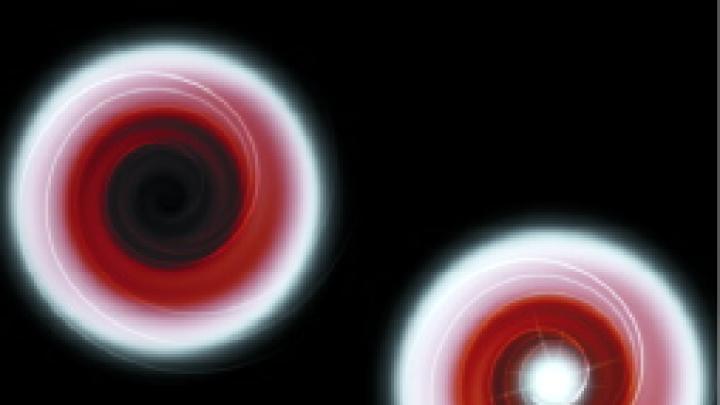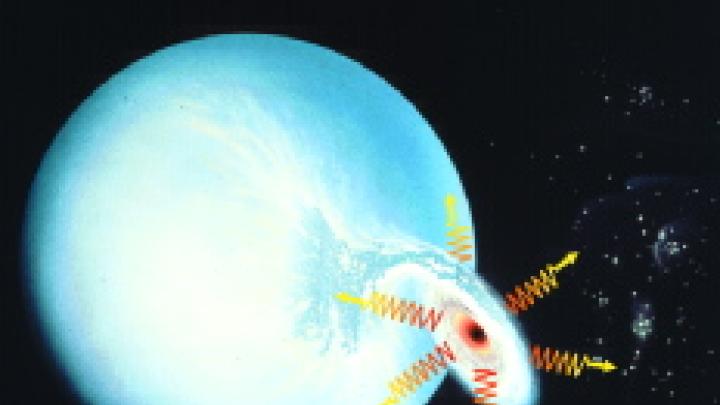In 1796, prompted by Isaac Newton's gravitational theories, French scientist Pierre-Simon Laplace was the first to ponder the possibility of black holes. In 1916, Albert Einstein's theory of general relativity predicted that a massive star would inevitably collapse into a black hole. And this year, astronomers at the Center for Astrophysics (CfA) presented data that strongly suggest the existence of an "event horizon"--the black hole's one-way boundary from which nothing, not even light, can escape. It is the most compelling empirical evidence yet that black holes exist.
"The data confirm the theory that black holes really have event horizons," says lead author Michael Garcia, referring to the paper he has submitted jointly with CfA colleagues Jeffrey E. McClintock, Stephen S. Murray, professor of astronomy Ramesh Narayan, and Irish astronomer Paul Callanan (University College, Cork) to the Astrophysical Journal.
A black hole is a gigantic star--at least three times the mass of the sun--that has burned up its core and collapsed on itself. What's left is a "hole" in space with gravitational forces so overwhelming as to prevent anything from leaving it. Matter, heat, energy--even light--are pulled in and vanish. "It is trivial to enter the black hole and totally impossible to return," says McClintock. "Once you're there, you can never return to our universe again."
The event horizon, an invisible membrane, marks a black hole's edge. Nothing that occurs within the event horizon, even a huge thermonuclear explosion, can have any effect outside the black hole. Thus, despite its extreme properties, an event horizon remains profoundly quiet. "There's no signpost. It's simply a location in space," says Garcia. "With a supermassive black hole, you could fly a spaceship right in and never know you were in a black hole--until you tried to turn around and leave."
Closer to the center of the hole, gravitational forces intensify, meaning that the shorter the distance between a black hole's event horizon and its center, the stronger the hole's gravitational forces. These forces become exponentially stronger with each inch closer to the center. Hence, merely entering the relatively small black holes studied by the researchers means "you'd be shredded to noodles," McClintock says.
Because no empirical evidence for black holes exists--in fact, by definition, no direct evidence can exist--some theoretical physicists argue there are no black holes, only black-hole candidates. "But in astronomy, we generally believe there are black holes," says Narayan. "We measure an object's mass, and it's too large to be anything else." An object 1.5 times the mass of the sun is presumed to be a neutron [collapsed] star. At three times the mass of the sun or greater, Einstein's theory of general relativity predicts the star will collapse into a black hole. The CfA researchers studied objects that ranged from five to 20 solar masses, elevating their status, at least according to astronomers, from candidates to genuine black holes.
The astronomers chose to observe 12 "binary systems," including six stars orbiting neutron stars and six stars orbiting what appeared to be black holes. These systems range in distance from 4,000 to 20,000 light years from Earth. In each one, gas (75 percent hydrogen, the rest mostly helium) streams off the orbiting star, becomes extremely hot, and releases flashes of energy. Using NASA's orbiting Chandra X-ray Observatory (see "Window on Darkness," November-December 1999, page 19) the researchers recorded these flashes, called x-ray novae.
Scientists can't observe a black hole directly (there is literally nothing to observe but blackness), but they can study its effects on surrounding objects. Gas particles collide as they stream off a star, creating friction as well as tremendous heat energy. Eventually, the gas becomes so hot (70,000 times as hot as the center of our sun) that it produces x-rays. "If you rubbed your palms together at the speed of light, you'd emit x-rays too," says Garcia. Using Chandra data, the researchers observed gas from orbiting stars being pulled into the event horizon.
A comparison of x-rays among the binary systems revealed a marked difference in luminosity between the neutron stars and the suspected black holes. When hot gas fell onto a neutron star, the heat energy produced x-ray novae as it radiated into space. But in a black hole, the event horizon pulled gas in, "hiding" the energy. "The black holes were one-hundredth the brightness of the neutron stars," says Narayan.
Differences in luminosity between the systems will inevitably spark alternative explanations, Narayan predicts. "Maybe the black hole is 100 times dimmer because it's more massive," he says. "This problem will be sitting there and more people will bang their heads on it. But that's the nature of science.










